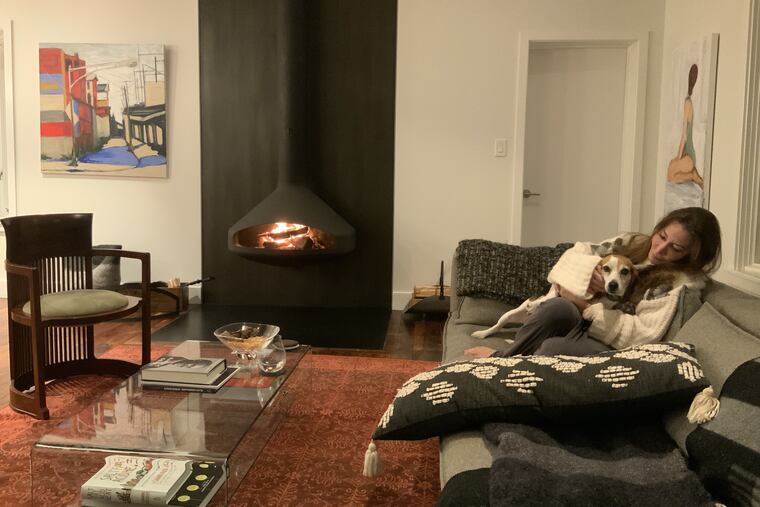Longing to cozy up in front of a fire? There are lots of options.
Wood is less energy efficient — essentially a hole in the house with a draft — while gas is simpler to use, and natural gas is abundant in the market.

Nothing makes JC Berland happier than curling up with a book with his wife, Laura, and rescue Beagle, Cammie, in front of the fireplace. In fact, he has shunned television for the fireplace, which offers him a sense of relaxation and peace in addition to heat. His round, black steel fireplace is modern, chic, and elegant.
“I’m an engineer so I really focus on efficiency and the elegance of the design,” said Berland, who moved to the area from France 20 years ago and now lives in Wayne. “All your attention is on the fire, not the brick or stones that are around it. It’s almost like a sculpture.”
He worked with Dreifuss Fireplaces in Northeast Philadelphia and had the fireplace shipped from France. It was an integral part of the home they bought and completely gutted two years ago. The wood-burning fireplace, three feet in diameter, efficiently heats their entire living room and kitchen.
“I crank up the fireplace every single day in the winter,” Berland said. “It’s the focal point of the house, and we gather around it. It’s my live TV, always vibrant, and the fire is always different.”
» READ MORE: DIY home improvement projects you can do in the winter
With COVID-19 forcing many people to spend more time indoors, or looking to find a way to stay outside as the weather gets colder, fireplaces may be a solution, said Emily McGee, director of communications for the Arlington Virginia-based Hearth, Patio, and Barbecue Association.
“People are trying to personalize their living space, and for some people, that might be a very interesting fireplace,” McGee said. “With people not traveling as much and vacations canceled, there might be more disposable income.”
Recent fireplace trends include fireplaces in kitchens, bedrooms, and even bathrooms, in addition to dens and living rooms. Smaller fireplaces are being designed to accommodate people living in smaller homes, and electric fireplaces offer flexibility because they don’t need a chimney.
If you are thinking about updating your existing fireplace, think about what you hope to accomplish, McGee said. Do you just want to update an outdated appearance, or is there a problem with the amount of heat it generates? Do you want to switch from wood burning to gas? It is crucial to have an experienced fireplace professional involved to understand what your current construction can accommodate and a lot of that may be behind the walls, she said.
David Waldman, owner of Dreifuss Fireplaces, has been busy during the pandemic. “People are home,” he said. “It’s just as much for the ambience and aesthetic as it is for heat.”
Modern, rectangular linear fireplaces remain popular with a new twist — no longer just glass media but more traditional media, including different logs and minimal metal. Orb fireplaces, like Berland’s, are also selling more. Some can be installed in the center of a room but rotate to face different directions. Outdoors, linear gas or big round fire pits are popular.
Another new trend is installing a heat shift system to protect a TV or art above a fireplace from the heat.
“The manufacturers have come up with ways to deflect the heat from coming out from the top of the fireplace to the base of the television, to coming out of the top of the wall above the television,” he said. “So you’re still getting the heat and ambience from the fireplace but a relatively cool wall so the TV or art isn’t affected by the heat.”
» READ MORE: Custom woodwork can bring warmth, strength and permanence to an office or home
When Justin Bresson bought his home in Wynnewood last year, a fireplace was a must. In fact, his house has two.
“Our living room is our main congregating area, and it has a gas fireplace that I turn on every morning, especially now that we’re home,” Bresson said. “Upstairs in our bedroom is a wood-burning fireplace. I have a half a cord of wood out back and part of my nighttime routine is making sure I bring up enough wood to start a fire before we go to bed at night.”
Sometimes he starts the fire earlier as a snuggling spot for his three children after bath time. “That’s my favorite,” he said.
While Bresson is an avid fan of the smell and crackle of burning wood, today, gas is more popular, Waldman said. Wood is less energy efficient — essentially a hole in the house with a draft, he said — while gas is simpler to use, and natural gas is abundant in the market.
For those switching from wood burning to a gas fireplace, “it’s about the convenience, hitting a button, as opposed to dealing with the mess and labor of wood,” Waldman said. But there are important considerations in making the switch: What is your gas source, where is it located, and how are you going to physically get the gas to the fireplace?
After answering those questions, take measurements so you know what will physically fit. Determine what your goal is — heat, ambience or both. Finally, set a budget. Converting a wood fireplace to gas can range from $1,500 to many thousands of dollars if you want to completely change the facade.
While function and look are both considerations, what’s most important is safety, Waldman said. “We can do form, function and aesthetics,” he said, “we just need to understand how to do it safely.”